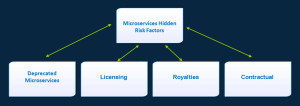“Microservices hidden risk factors for organizations to consider” is a post that exposes possible hidden risks for organization to consider as they gravitate towards leveraging Microservices as a competitive advantage over their competitions.
Microservices hidden risk factors for organizations to consider
Enterprises and entrepreneurs alike are under tremendous pressure to deliver competitive products which require to either develop or have access to various software capabilities to drive their innovation. They may choose to leverage Microservices to achieve their goals.
In my previous post, I described a Microservice as a service with an open architecture, designed to perform a specific and targeted task. Microservices provide capabilities to developers for accelerating their development and building differentiation into their applications.
There is no doubt about the tremendous rewards for organizations to consume Microservices to help drive their innovation and differentiating themselves from their competitors. However, besides the risk associated with the vendor lock-in, there are factors they should consider as they gravitate towards using these services.
[AdSense-C]
Figure 1. depicts some of these factors which are centered around the following risks:
Deprecated Microservices: Microservices eventually get deprecated. Microservices providers may either replace, halt further development, cease support or simply remove Microservices from their catalogs. Software that depends on a depricated Microservice will be impacted. Unfortunately, organizations have to absorb all the development cost for modifying existing code to leverage a newer or another version of the Microservice if one exists. They may also be impacted by a revenue loss and face the risk of not meeting their SLAs. The impact may also be significant if they cannot leverage another Microservice with similar capability forcing them to sunset their software. Organizations will be faced with a possibility of loosing their competitive edge in the marketplace.
Licensing: Microservices providers charge organizations a premium for consuming their Microservices. These providers may increase the licensing cost when the renewals are due. Organizations may find the new pricing structures not suitable for their businesses. However, they may have limited flexibility in negotiating new terms with the vendors if they have dependencies on their proprietary Microservices.
Royalties: Organizations may offer their software as a Software as a Service (SaaS) with a set profit margin. They may integrate third party Microservices into their software. Microservices providers more likely will charge royalties for these services. These royalties may increase over time impacting the profit margins made on the SaaS offerings. Due to their dependencies on the proprietary Microservices, organization may find themselves at a disadvantage when negotiating the royalties forcing them to cease their SaaS offering.
Contractual (third party licensing): Microservices providers, in addition to their own Microservices, may list their business partners’ Microservices as part of their catalog. Organizations may incorporate them into their software. The contractual agreement between a Microservices provider and the business partner may desolve resulting in the removal the business partner Microservices from the catalog. Thus, organizations who are dependent on these Microservices are at a risk of no longer having access to certain capabilities provided by these Microservices.
Organizations should not consider these concerns as a show stopper. In my perspective, these concerns can be alleviated through appropriate planning and contract negotiations with the Microservices Cloud providers.
About the Author
 Sami Joueidi holds a Masters degree in Electrical Engineering and an Enterprise Architecture certification from Carnegie Mellon. He has over 20 years of experience as a technical leader of complex IT projects for Fortune 500 firms, in diverse roles such as Systems Integrator, DevOps, Cloud Architecture, Enterprise Architecture and Software Development & Release Management. He guides customers on how to leverage the latest technology trends to their advantage and helps them with their Cloud adoption strategies.
Sami Joueidi holds a Masters degree in Electrical Engineering and an Enterprise Architecture certification from Carnegie Mellon. He has over 20 years of experience as a technical leader of complex IT projects for Fortune 500 firms, in diverse roles such as Systems Integrator, DevOps, Cloud Architecture, Enterprise Architecture and Software Development & Release Management. He guides customers on how to leverage the latest technology trends to their advantage and helps them with their Cloud adoption strategies.
© Sami Joueidi and www.cafesami.com, 2015. Excerpts and links may be used, provided that full and clear credit is given to Sami Joueidi and www.cafesami.com with appropriate and specific direction to the original content.


Do you like to comment?